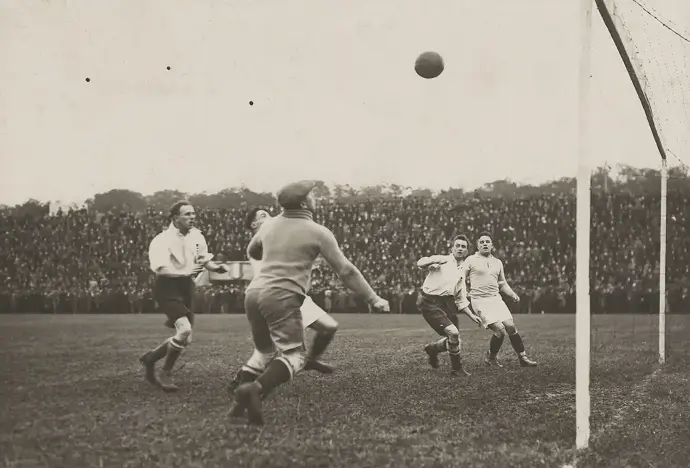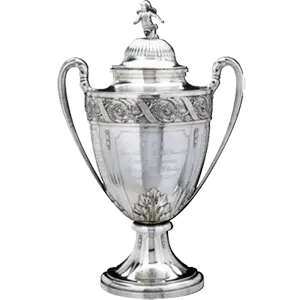Pierre Chayriguès
Pierre Chayriguès is certainly the first "modern" goalkeeper in the history of football. Very small for a goalkeeper, he will have marked the history of French football.

Games
Goals Conceded
Clean Sheets
Trophies
1907/08 JAS Levallois (FRA)
1908/11 USA Clichy (FRA)
1911/25 Red Star (FRA)
With the National Team :
21 selections
(Friendly matches: 21 selections)
1st selection: October 29, 1911 against Luxembourg (4-1)
Last selection: May 21, 1925 against England (2-3)

Pierre Casimir Laurent Chayriguès
Born on May 2, 1892 in Paris (FRA)
Died on March 19, 1965 in Levallois-Perret (FRA)
French, Goalkeeper, 1m70
Nickname: "Pierrot les grandes mains"
The first "modern" goalkeeper in history
Pierre Chayriguès was born on May 2, 1892 in Paris, France. Born in the sixteenth arrondissement of Paris, he will put on the gloves for the first time for the Jeunesse Athlétique Socialiste de Levallois club before joining the Union Sportive et Amicale de Clichy in 1908.
Having a unique style for his time, he explained that the goalkeeper had to be more than a bulwark nailed to his goal line, so he advanced more, diving at the feet of his opponents, cutting passes and stopping shots as soon as the ball was released.
Another unique thing about his style was that he was the first to relaunch the balls as soon as he could, loving to see his team play on the counterattack. He is also considered the "inventor" of fist clearances, exits into the opponents' feet and diving. He would also suffer several injuries throughout his career for these reasons.
So young and yet already the best goalkeeper in the country
Despite his small size, 1m70, he was endowed with excellent vertical relaxation and magnificent reflexes, making him an incredible goalkeeper on his line. By 1908, he had the level to join the French national team but he could not. The reason? At the time, French football was divided into two competing federations. On one side, the USFSA, the Union of French Athletic Sports Societies, which chose to leave FIFA in 1908. On the other, the CFI, the French Interfederal Committee, which replaced the association within the international federation and which then held the monopoly on official representation. However, the Clichy club for which Chayriguès kept goal was affiliated with the first, unrecognized one. If he wanted to wear the blue jersey, the young Parisian had no choice, he had to change clubs. He didn't hesitate and joined Red Star in 1911.
Pierre Chayriguès then became the new starting goalkeeper for the French National Team. An electrician by trade, he suddenly became one of the first players in history to be paid, in fact, although professional football did not appear in France until 1932, he signed an agreement with his club Red Star which earned him a signing bonus of 500 francs, then a monthly salary of 400 francs and finally a bonus of 50 francs for each victory.
When he was only 19 years old, he was already one of the best goalkeepers in the world, and one of the most impressive. He then earned 4 times the average salary of a schoolteacher at the time, an astronomical sum for the time. He was already a star in his country.
His story with the French national team began on October 29, 1911, this match was a great success, a 4-1 victory for the French team, on the occasion, he broke a record, that of the youngest starting goalkeeper in the French team with 19 years, 5 months and 28 days. One of his reference matches was in 1912, against Italy in Turin, France won 4 goals to 3. At the time, France was not shining internationally unlike Italy, this victory was then a huge success, a victory largely due to Chayriguès who made many saves. Subsequently, he participated in the Paris Olympic Games in 1924, where he was eliminated in the quarter-finals by the winner of the edition: Uruguay.
A career undermined by injuries
The goalkeeper impressed as he created debates, considered crazy by many, he was considered by others as a living legend of this sport. His numerous exits in the feet of the attackers will earn him many injuries at a time when the goalkeepers were not as protected as now.
He will notably suffer fractures of the pelvis and the shoulder during the Inter-Allied Games (multi-sport competition intended for the military personnel who participated in the combats of the First World War on the side of the Triple Entente) of 1919. In 1924, during the Olympic Games, he had a rib pushed in during a violent contact with Pedro Petrone. In 1925, he suffered a fracture of the ankle and the fibula, a final injury that would put an end to his career, when he was only 33 years old and he was still the best goalkeeper in the country and among the best in the world.
At club level, the French football star won the Coupe de France three times, which was the country's most prestigious trophy at the time. He won three French Cups in a row, in 1921, 1922 and 1923, quite an achievement. Wearing leather gloves to resist the cold in winter, he played his last international cap on May 21, 1925, during a 3-2 defeat against England.
A businessman goalkeeper
Pierre Chayriguès could have had an even better career, since in 1913, he was approached by Tottenham Spurs, knowing the greatness of his talent, the English club offered him four times his salary from Red Star, which was the equivalent of 16 times the average salary of a French schoolteacher at the time. But he ultimately refused the offer, preferring to stay in France.
Finally, he received the same salary as the one Tottenham offered Red Star some time later. Considered the first rebel of French football, he once went to the FFF headquarters on crutches to demand money for treatment, while he was already earning between 1,000 and 3,000 francs per match.
From 1922, he categorically refused to play matches for free. "I have neither shame nor regret to have been paid." He had already understood everything about the football business and refused to be ripped off by the clubs of the time, seeing in the profits of clubs, a part of his possible salary.
Trophies :

French Cup x3
- 1921 (Red Star)
- 1922 (Red Star)
- 1923 (Red Star)
Finalist Inter-Allied Games x1
- 1919 (France)